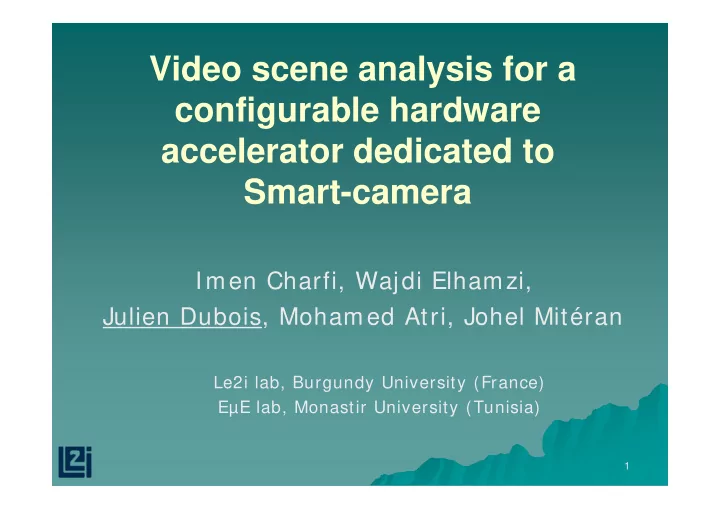

Video scene analysis for a configurable hardware accelerator dedicated to Smart-camera Imen Charfi, Wajdi Elhamzi, Julien Dubois, Mohamed Atri, Johel Mitéran Le2i lab, Burgundy University (France) EµE lab, Monastir University (Tunisia) 1
Video coding diversity Diversity in client devices Different types of core and access netw orks Diversity of content form ats / standards DVB-T/S/C/H UMTS, GPRS, cable, ADSL, dial-up, ... ♪♫♪ ♪♫ ♪♫ ♫♪ How to handle w ith such diversity ? 2 How to provide a video codec able to support such diversity?
Video codec embedded in a Smart camera A significant contribution to handle w ith the diversity ! More challenging : flexibility to deal w ith environm ent constraints 3
Dynamic adaptation Scene analysis : QoS analysis (network, event detection user configuration) 4
Current investigations Scene analysis : QoS analysis (network, user PhD on automatic Fall configuration) detection Project with industrial partner (Re)Configurable Codec PhD on motion estimation 5
Automatic Fall detection Imen Charfi’s PhD 1 vector of 3584 features / frame Data base available (60 videos, extension at 130 videos done) 6
Detection Results SVM : Classification error rate 3% error < 0.02 % per frame After final filtering and Bounding box Manually annotated error < 0.05 % per frame After final filtering and Bounding box automatically annotated 7
Detection Results Two preliminary evaluations show similar performances achieved : on the extended video-data set (130 videos) using boosting instead of SVM (from 10 to 100 time faster) The regularity and the complexity of boosting method enables a FPGA hardware implementation to be investigated. Technical lock : the real-time processing of all features Johel MITERAN, Jiri MATAS, Elbey BOURENNANE, Michel PAINDAVOINE, Julien DUBOIS " Autom atic Hardw are I m plem entation Tool for a Discrete Adaboost-Based Decision Algorithm ", EURASIP Journal on Applied Signal Processing, Hindawi, 2005 (7), pp. 1035-1046, 2005 Fethi SMACH, Johel MITERAN, Mohamed ATRI, Julien DUBOIS, Mohamed ABID, Jean Paul GAUTHIER, " An FPGA-based accelerator for Fourier Descriptors com puting for color object recognition using SVM ", Journal of Real-Time Image Processing (JRTIP), Springer, vol.2, pp. 249-258, 2007. Khalil Khattab, Julien Dubois and Johel Miteran, "Cascade Boosting Based Object Detection from High Level Description to Hardw are I m plem entation", EURASIP Journal of Embedded Systems, Special Issue "Design and Architectures for Signal Image Processing", Hindawi, 12 pages, 2009. 8
Current investigations How to use the detection results to adjust the video coding performances ? Scene analysis : QoS analysis (network, user PhD on automatic Fall configration) detection Project with industrial partner (Re)Configurable Codec PhD on motion estimation More than 60 % of the compression More than 60 % of the processing time 9
ME principle Image split in 16x16 macro-block Each macro-block = > one motion vector 10
How ME be flexible ? Fast search algorithms: Processing time can be reduced up to 99% Several search phases required Impact on bit-rate and on PSNR + 4 dB (also 45 % of overall processing time) 11
Architecture Overview Wajdi Elhamzi’s PhD 12
Integer ME architecture 13
Halfpel & Quaterpel Co-processors 14
Halfpel & Quaterpel Co-processor 610 cycles!!!! 1080 HD video streams at frame rate of 29 fps !!!! 15
Overview of the proposed implementation In IME : 752x576 video streams at 67 fps (in FS mode) In FME: 1080 HD (1920x1088) video streams at frame rate of 29 fps (around 232K Macroblocks/ s) 16
Future works : Improve FME (preliminary results very promising) Dynamic reconfiguration of the motion estimator Investigation on other configurable parts of the codec (DCT, quantification… ) Design of a hardware video codec with the configurable motion estimation 17
Conclusion Our contributions for a smart camera design with adaptive video coding: Configurable low-cost motion estimator based on FPGA component with competitive performances Fall detection algorithm defined and hardware implementation currently investigated 18
Questions ? 19
Event detection Imen Charfi’s Thesis 20
Temporal Filtering of classification results 21
Commun parts in H.264 Motion estimator architecture which support any search strategy! Must support H.264 features! 22
Fast search strategy ? H.264 features supported + Different search strategies supported LDSP SDSP Others reduced search: Three Steps… . Example 23
Random search One solution : prediction + random search Several phases requested ! More complex nevertheless dynamic modifications can be considered 24
Integer ME architecture 25
R. Mosqueron Smart Camera J. Dubois M. Paindavoine CMOS sensor : 500 images/s, 1280 * 1024 pixels sur 10 bits Bandwidth required 6.55Gb/s. USB2 Bandwidth : Peak 340Mb/s upto 480Mb/s Average 200Mb/s Compression ration 30 : 6.55 / .20 ≈ 30 Others pre-processing implented 26
Smart camera with heterogeneous architecture RS-232 RS-485 CMOS interfaces USB SDRAM Sensor Dig I/O System Processeur COP Controleur Trimedia PCI Ethernet VGA PCI Controleur Controler Extension 27
Heterogeneous smart camera prototype RS-232 RS-485 Capteur interfaces USB SDRAM CMOS Dig I/O Contrôleur Trimedia COP système PCI Contrôleur Contrôleur Extension Ethernet VGA PCI 28
Application : postal sorting 29
30 Application : postal sorting
J. Dubois J. Mitéran SystemC Modelisation W. Elhamzi I. Charfi K. Khattab Face Detection and localisation based Viola-Jones method All Sub-windows Further processing Object 2 4 1 3 No object -1 +1 +1 -1 +1 +1 -1 +1 -1 +1 Rejected Sub-windows -1 D A B C Cascade detector Haar Features 31
Architecture model BLOCK 1 : - 4 to 8 Mem.1 II features Imag e Features Decision i - 100% Sub windows II Block 1 Positives Sub i 1 - 35% total Shift&Scale windows memory addresses access Sub windows Sub windows BLOCK 2 : addresses addresses Mem.2 - 8 to 20 features - <50% sub windows II Block 2 Mem.3 i 2 II - 35% total Decision Features i 1 memory access Sub windows Sub windows BLOCK 3 : addresses addresses - up to 2000 Mem.4 features - <15 % sub windows II Block 3 3 i - 30% total II Features Decision i 2 memory access Decision 32
Implementation Tool : SystemCrafter 33
Recommend
More recommend